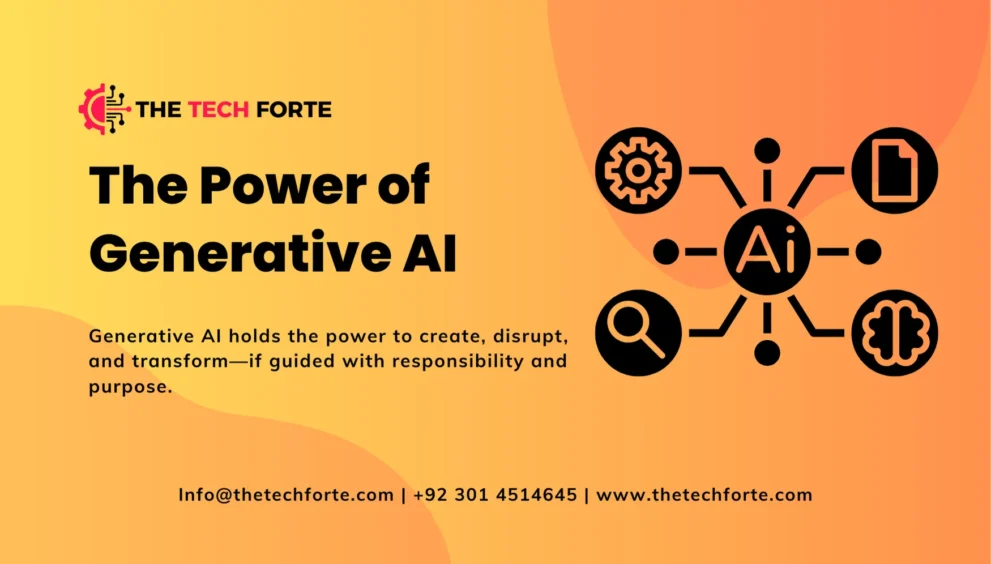The Power of Generative AI: Opportunities, Risks, and Responsible Use Cases

Last year, a small startup in New York faced a huge challenge. They wanted to design a series of professional marketing campaigns, but couldn’t afford the cost of hiring a full creative team. Instead, they turned to generative AI tools like ChatGPT and MidJourney. Within days, they had unique ad copy, product visuals, and even short video concepts all at a fraction of the traditional cost. This story reflects the transformative power of generative AI: it’s not just a futuristic concept anymore; it’s reshaping how businesses and individuals work today.
What is Generative AI?
It refers to artificial intelligence systems capable of creating new content, whether it’s text, images, music, code, or even 3D models. Unlike traditional AI, which classifies data or makes predictions, generative AI produces something new. For example, where a predictive model might forecast the weather, a generative model could write a weather report in natural language. This ability to generate outputs that resemble human creativity makes generative AI one of the most exciting innovations of our time.
How Generative AI Works:
It runs on advanced machine learning techniques such as Large Language Models (LLMs) and diffusion models. These systems are trained on massive datasets, learning patterns, structures, and contexts to create realistic outputs.
- LLMs like GPT specialize in generating human-like text.
- Diffusion models are used in tools like DALL·E and Stable Diffusion for creating images.
- Multimodal systems combine text, audio, and visuals for a richer experience.
For example, when you type a prompt like “design a futuristic cityscape at sunset” into an AI image tool, the model transforms words into visual art by interpreting patterns it has learned from millions of images.
Applications of Generative AI Across Industries:
It is no longer limited to tech labs; it has found a home across multiple industries:
- Marketing & Advertising: Brands use AI to generate personalized ad copy, slogans, and visual campaigns at scale.
- Healthcare & Drug Discovery: Researchers apply AI to design molecules and predict how drugs interact with the human body.
- Education: AI tutors create customized lesson plans based on student needs.
- Software Development: Developers use generative AI to write, test, and debug code.
- Entertainment & Design: Musicians, writers, and game developers use AI for brainstorming and content creation.
These applications highlight why businesses of all sizes are exploring the potential of AI.
Benefits of Generative AI:
The true power of AI lies in the tangible benefits it delivers:
- Productivity Boost: AI handles repetitive tasks, freeing humans to focus on strategy and innovation.
- Creativity on Demand: Designers, marketers, and writers can brainstorm ideas in seconds.
- Cost Savings: Companies save money by reducing reliance on external resources.
- Scalability: Businesses can generate content or solutions at a pace that humans alone cannot match.
For example, an e-commerce company used generative AI to automatically generate thousands of unique product descriptions, boosting both search rankings and sales conversions.
Risks and Ethical Challenges:
While the benefits are compelling, generative AI also carries serious risks:
- Deepfakes and Misinformation: AI-generated videos can spread false narratives.
- Intellectual Property Issues: Questions arise over who owns AI-generated content.
- Bias and Fairness: Models trained on biased data may unintentionally produce discriminatory outputs.
- Data Privacy: Sensitive information could be misused if not handled carefully.
Imagine a political campaign using AI-generated videos to create fake speeches — the consequences could be damaging for society. This is why transparency and regulation are essential.
Governance and Responsible AI Use:
Responsible adoption of generative AI requires clear governance models. Businesses and governments are already stepping in with regulations like the EU AI Act and GDPR guidelines.
Best practices include:
- Keeping humans in the loop for oversight.
- Ensuring AI systems are transparent and explainable.
- Conducting regular bias and risk assessments.
A company integrating generative AI into recruitment, for example, should test the system regularly to avoid discriminatory practices against candidates.
Practical Steps to Adopt Generative AI:
Organizations eager to embrace generative AI should take a structured approach:
- Start with pilot projects to test AI tools on small-scale tasks.
- Train employees in prompt engineering and AI literacy.
- Evaluate vendors carefully to ensure security and compliance.
- Establish clear policies for ethical AI use.
By moving gradually, businesses can avoid costly mistakes and gain confidence in scaling AI solutions responsibly.
Future Outlook of Generative AI:
Looking ahead, generative AI is expected to become even more powerful and integrated into daily life. Future trends include:
- Smarter multimodal models that combine text, audio, and video seamlessly.
- Job transformation, where AI becomes a collaborator rather than a replacement.
- Sustainability concerns, as the computing power behind AI raises questions about energy use.
Just as the internet reshaped industries two decades ago, generative AI is poised to transform how we live, work, and create.
Conclusion:
Generative AI is a double-edged sword. On one side, it unlocks unprecedented opportunities for creativity, productivity, and innovation. On the other hand, it brings risks that demand careful management. The real power of generative AI lies not just in what it can create, but in how we choose to use it responsibly. For businesses, entrepreneurs, and individuals alike, the time to explore generative AI is now, but with transparency, ethics, and accountability at the center of adoption.





























































































































